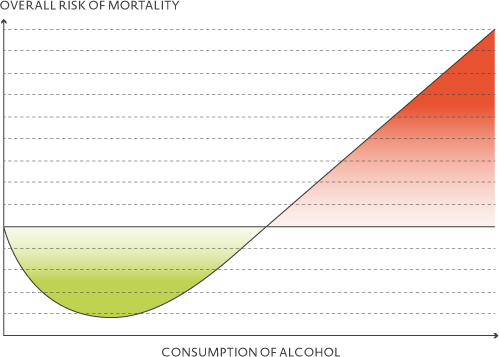Wine and Health
As supported by scientific literature, more than half of the protective effects of the moderate consumption of alcoholic beverages come courtesy of the alcohol itself
The moderate consumption of alcohol is associated with, among other things, reduced rates of cardiovascular diseases.
The majority of early studies only associated the average quantity of alcohol consumed with the length of time (generally a week) as an indicator of alcohol consumption; however, this average did not take into account the associated risk related to the consumption guidelines, such as sporadic excessive drinking. A lot of more recent studies have emphasized that the consumption guidelines are likely to be the best indicator regarding alcohol exposure. Many studies indicate that the "healthiest" consumption guideline is the consumption of small quantities of alcohol (generally defined as between 1 to 3 standard drinks/day), on a frequent basis (daily or at least several times per week).

The mechanisms behind the protective effects of alcohol
Good cholesterol
Moderate consumption increases the number of high-density lipoproteins (HDL – good cholesterol) that are linked to cholesterol and its passage to the liver for elimination or reprocessing. HDL help avoid cholesterol deposits in the arteries and deter atheroma plaque formation:
- Reduced oxidation of the low-density lipoproteins (LDL – bad cholesterol) that are involved in the development of atherosclerosis;
- Reduced fibrinogen, which reduces the risk of blood clots that can block the passage of blood in the arteries and result in a heart attack or stroke;
- Reduced platelet aggregation;
- An improvement in the functioning of the endothelium (the interface between the artery wall and blood) – the endothelium plays an important part in maintaining vascular tonicity.;
- Endothelial dysfunction precedes atherosclerosis. Studies indicate that the moderate consumption of alcohol, particularly red wine, improves this function.
In addition, alcohol has a general anti-inflammatory effect that affects blood vessels in a positive way, slowing down the appearance of atherosclerosis. Atherosclerosis is the principal cause of cardiac arrest and consists of build ups of atheromatous plaque that are nothing more than fat deposits inside arteries. This plaque provokes the narrowing, or stenosis, of the arteries and therefore totally or partially impedes the passage of blood through them. The consequences of stenosis in the arteries due to atheromatous plaque will be restricted bloodflow in affected areas, which causes irreversible injury in the region (cardiac arrest).
Phenolic compounds and prevention
Wine is an alcoholic beverage with an incredibly high concentration of biologically active compounds, particularly phenolic compounds (resveratrol, quercitin, epicatechin, tannins, anthocyanins...), which are responsible for its organoleptic characteristics, such as flavour, astringency and body. The anti-oxidant action of these compounds seems to inhibit the oxidation of LDL, preventing the development of atherosclerosis: the principal cause of coronary disease.
Furthermore, these phenolic compounds combat the action of free radicals, that cause premature aging and the development of diseases such as Parkinsons, Alzheimers and some types of cancer.
Type 2 Diabetes
Scientific evidence currently indicates that the moderate consumption of alcohol (1-2 drinks a day) is associated with a reduced (around 30% lower) risk of Type 2 Diabetes, compared to those who abstain from alcohol or consume less.
However, excessive consumption is associated with an increased risk. The link between Type 2 Diabetes and alcohol consumption seems to be in the form of a 'J' – where the risk of developing it increases upwards of 4 drinks a day.